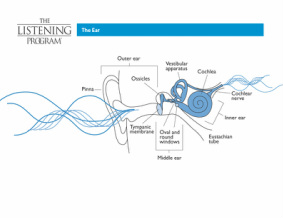The Listening Program (TLP) is a music listening therapy,
that provides engaging brain stimulation to improve
performance in school, work and life.
that provides engaging brain stimulation to improve
performance in school, work and life.
Systematic training is provided through listening to psychoacoustically modified classical music which trains the brain to process sound more efficiently. This leads to improvements in:-
- Learning
- Listening
- Self Regulation
- Attention
- Sensory Processing
- Musical Ability
- Communication
- Social Engagement
- Brain Fitness
- Reading
- Behavior
- Daily Living
Children, teens, adults and seniors can use the program in the home, classroom or workplace. Completely portable and easy to use, The Listening Program fits easily into anyone's schedule and only requires 15 to 30 minutes of daily listening.
- Learning
- Listening
- Self Regulation
- Attention
- Sensory Processing
- Musical Ability
- Communication
- Social Engagement
- Brain Fitness
- Reading
- Behavior
- Daily Living
Children, teens, adults and seniors can use the program in the home, classroom or workplace. Completely portable and easy to use, The Listening Program fits easily into anyone's schedule and only requires 15 to 30 minutes of daily listening.
The Ear Brain Connection
So the question becomes...how can we overcome
auditory processing challenges-moving from
a "disorganized" to an "organized" system.
So the question becomes...how can we overcome
auditory processing challenges-moving from
a "disorganized" to an "organized" system.

Specific Frequencies for Specific Functions
Certain classical music, like that of Mozart, Haydn and Vivaldi, has specific structure, producing sound waves in organized patterns. Within these patterns are vital elements including time, frequency and volume. When listening to music, the ear is receiving the musical sound waves - waves that arrive in different frequencies, measured in Hertz (Hz). These frequencies stimulate thebrain, and thus affect different functions of the mind and body.
Certain classical music, like that of Mozart, Haydn and Vivaldi, has specific structure, producing sound waves in organized patterns. Within these patterns are vital elements including time, frequency and volume. When listening to music, the ear is receiving the musical sound waves - waves that arrive in different frequencies, measured in Hertz (Hz). These frequencies stimulate thebrain, and thus affect different functions of the mind and body.
 RSS Feed
RSS Feed
